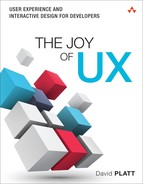Foreword
Occasionally you meet a teacher who’s so enthusiastic about what he teaches that the enthusiasm rubs off almost contagiously. David is that rare kind of teacher. I’ve seen it live in his classes and with his students. I see that same love and enthusiasm in The Joy of UX, and I know you will too.
I have to confess: I’m the wrong person to write this foreword. I may have the world’s worst natural sense of user interface design. But over the years, and especially with the assistance of David Platt, I’ve produced some pretty great software. The software produced by the teams I’ve led has generated billions in revenue and has been used by millions of people.
Incredibly, I’ve also learned to enjoy creating breathtaking UX. I once thought building a great user experience was a tedious process, primarily about colors and fonts and something to do with the golden ratio. Far more critical are the tools and techniques David teaches: empathy for your user, hypothesis testing, and iterating on those hypotheses by watching how users interact with the software. Put another way: fall in love with your users and prioritize their happiness.
When I finally embraced the techniques and processes David writes about in this book, I didn’t just end up creating delightful user experiences. It also had a profound effect on how I develop software. At the heart of a great user experience is empathy for the user. Developing this empathy requires a true understanding of who your users are. This changed my entire orientation from thinking about what (What code should I write? What language should I use? What is the technology?) to thinking in terms of who and why. This requires hard work and hard thinking. You must leave your keyboard behind and adventure out into the world. You must meet the people who are using (or will use) your software and talk to them. They will surprise you. They will defy expectations. After you build, you must go back to them and continuously develop your relationship and understanding of how they think, what motivates them, and discover the “why” behind what drives them.
I also learned to take a much more iterative approach to software development. “I should build feature ‘X’” turns into a hypothesis that needs to be validated—by the customer. Applying a user-centric process to all feature decisions made my process leaner than just using a Kanban board or Scrum. To determine what to build next, we must determine what will have the highest impact on the user’s experience.
These techniques are vital today, especially when building mobile applications. End users have tremendous choices. They are fickle. If they don’t grok your application immediately, they’ll never touch it again.
You can delight your users by incorporating David’s advice into your workflow. Get inside your users’ heads, develop a deep understanding and empathy for their lives, test your assumptions, and discover “why.”
—Keith Ballinger
Vice President of Product at Xamarin
